
Concept explainers
(a)
Interpretation: The constitutional isomer formed by the reaction of given alkene with [1]
Concept introduction: The compounds with same chemical formula but different arrangement of atoms in space are known as the constitutional isomer.
Hydration of
Answer to Problem 10.29P
The constitutional isomer formed by the reaction of given alkene with

Figure 1
The constitutional isomer formed by the reaction of given alkene with
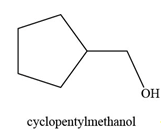
Figure 2
Explanation of Solution
The compounds with same chemical formula but different arrangement of atoms in space are known as the constitutional isomer.
Hydration of alkenes is one of the methods used for the formation of alcohol.
Hydroboration reaction is a two step reaction, which involves conversion of alkene into alcohol. This type of reaction follows Anti-Markovnikov’s rule.
In hydration reactions, the mode of addition is anti-addition, whereas in hydroboration-oxidation, the mode of addition is syn addition.
The given alkene is,
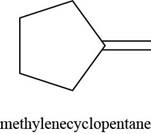
Figure 3
The product formed by the reaction of methylenecyclopentane with

Figure 4
The general steps followed by the hydration reaction are stated below:
• First protonation of the alkene take place to generate the carbocation.
• Formation of protonated alcohol.
• Deprotonation.
The product formed by the reaction of methylenecyclopentane with

Figure 5
The constitutional isomer formed by the reaction of given alkenes with [1]
(b)
Interpretation: The constitutional isomer formed by the reaction of given alkenes with [1]
Concept introduction: The compounds with same chemical formula but different arrangement of atoms in space are known as the constitutional isomer.
Hydration of alkenes is one of the methods used for the formation of alcohol.
Answer to Problem 10.29P
The constitutional isomer formed by the reaction of given alkenes with
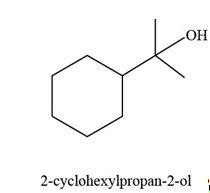
Figure 6
The constitutional isomer formed by the reaction of given alkenes with
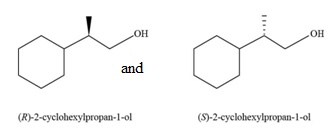
Figure 7
Explanation of Solution
The compounds with same chemical formula but different arrangement of atoms in space are known as the constitutional isomer.
Hydration of alkenes is one of the methods used for the formation of alcohol.
Hydroboration reaction is a two step reaction, which involves conversion of alkene into alcohol. This type of reaction follows Anti-Markovnikov’s rule.
In hydration reactions, the mode of addition is anti-addition, whereas in hydroboration-oxidation, the mode of addition is syn addition.
The given alkene is,

Figure 8
The product formed by the reaction of

Figure 9
The general steps followed by the hydration reaction are stated below:
• First protonation of the alkene take place to generate the carbocation.
• Formation of protonated alcohol.
• Deprotonation.
The product formed by the reaction of
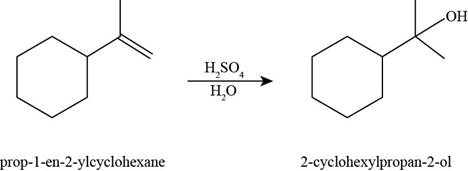
Figure 10
The constitutional isomer formed by the reaction of given alkenes with [1]
(c)
Interpretation: The constitutional isomer formed by the reaction of given alkene with [1]
Concept introduction: The compounds with same chemical formula but different arrangement of atoms in space are known as the constitutional isomer.
Hydration of alkenes is one of the methods used for the formation of alcohol.
Answer to Problem 10.29P
The constitutional isomer formed by the reaction of given alkene with
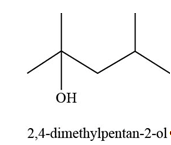
Figure 11
The constitutional isomer formed by the reaction of given alkene with

Figure 12
Explanation of Solution
The compounds with same chemical formula but different arrangement of atoms in space are known as the constitutional isomer.
Hydration of alkenes is one of the methods used for the formation of alcohol.
Hydroboration reaction is a two step reaction, which involves conversion of alkene into alcohol. This type of reaction follows Anti-Markovnikov’s rule.
In hydration reactions, the mode of addition is anti-addition, whereas in hydroboration-oxidation, the mode of addition is syn addition.
The given alkene is,
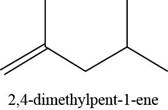
Figure 13
The product formed by the reaction of methylenecyclopentane with

Figure 14
The general steps followed by the hydration reaction are stated below:
• First protonation of the alkene take place to generate the carbocation.
• Formation of protonated alcohol.
• Deprotonation.
The product formed by the reaction of methylenecyclopentane with

Figure 15
The constitutional isomer formed by the reaction of given alkenes with [1]
Want to see more full solutions like this?
Chapter 10 Solutions
ORGANIC CHEMISTRY
- Why is analysing salt content (using Mohr titration) in both regular & salt reduced tomato sauce important?arrow_forwardIn the image below, correctly name the glassware # _P ( Blank 1) and T ( Blank 2). 景 A W Blank # 1 Blank #2 1000 +19 E E D 0 0-0 G H A A K Π 12 R M N S 0-0-arrow_forwardFeedback: Your answer is incorrect. Predict the major products of the following organic reaction: CN Δ + A ? NC Some important notes: • Draw the major product, or products, of the reaction in the drawing area below. • If there aren't any products, because no reaction will take place, check the box below the drawing area instead. • Be sure to use wedge and dash bonds when necessary, for example to distinguish between major products that are enantiomers. esc Check 80 MH F1 F2 F3 F4 F5 50 @ # C % 95 € Save For Later Sub 2025 McGraw Hill LLC. All Rights Reserved. Terms of Use | Privacy C A DII F6 F7 F8 7 * 8 Λ & 6 F9 F10 9 0 4arrow_forward
- Incorrect Feedback: Your answer is incorrect. Predict the major products of the following organic reaction: ཤིགས་བྱ རྩ་ཅད་ཀྱིས་༢༩ + Some important notes: A ^ ? • Draw the major product, or products, of the reaction in the drawing area below. • If there aren't any products, because no reaction will take place, check the box below the drawing area instead. • Be sure to use wedge and dash bonds when necessary, for example to distinguish between major products that are enantiomers. E Check 0 لا Save For La ©2025 McGraw Hill LLC. All Rights Reserved. Terms of All F9 Aarrow_forwardPredict the major products of the following organic reaction: + Δ A ? Some important notes: • Draw the major product, or products, of the reaction in the drawing area below. • If there aren't any products, because no reaction will take place, check the box below the drawing area instead. • Be sure to use wedge and dash bonds when necessary, for example to distinguish between major products that are enantiomers. Explanation Check Click and drag to start drawing a structure. 2025 McGraw Hill LLC. All Rights Reserved. Terms of Use Privaarrow_forwardesc 2 Incorrect Feedback: Your answer is incorrect. Can the molecule on the right-hand side of this organic reaction be made in good yield from no more than two reactants, in one step, by moderately heating the reactants? ? A O • If your answer is yes, then draw the reactant or reactants in the drawing area below. You can draw the reactants in any arrangement you like. . If your answer is no, check the box under the drawing area instead. Check F1 ! @ X C Save For Later Submit Assignment 2025 McGraw Hill LLC. All Rights Reserved. Terms of Use | Privacy Center | Accessibility 80 et A ད 1 4 F2 F3 F4 F5 F6 F7 F8 F9 F10 F11 F12 # $ 45 % A 6 87 & * 8 9 ) 0 + ||arrow_forward
- Can the molecule on the right-hand side of this organic reaction be made in good yield from no more than two reactants, in one step, by moderately heating the reactants? ?A Δ O • If your answer is yes, then draw the reactant or reactants in the drawing area below. You can draw the reactants in any arrangement you like. • If your answer is no, check the box under the drawing area instead. Explanation Check Click and drag to start drawing a structure. 2025 McGraw Hill LLC. All Rights Reserved. Terms of Use | Privacy Center | Accessibilit ku F11arrow_forward१ eq ine teaching and × + rn/takeAssignment/takeCovalentActivity.do?locator-assignment-take [Review Topics] [References] Write an acceptable IUPAC name for the compound below. (Only systematic names, not common names are accepted by this question.) Keep the information page open for feedback reference. The IUPAC name is In progress mit Answer Retry Entire Group 5 more group attempts remaining Cengage Learning | Cengage Technical Support Save and Exitarrow_forwardDraw the molecules.arrow_forward
- Draw the mechanism for the acid-catalyzed dehydration of 2-methyl-hexan-2-ol with arrows please.arrow_forward. Draw the products for addition reactions (label as major or minor) of the reaction between 2-methyl-2-butene and with following reactants : Steps to follow : A. These are addition reactions you need to break a double bond and make two products if possible. B. As of Markovnikov rule the hydrogen should go to that double bond carbon which has more hydrogen to make stable products or major product. Here is the link for additional help : https://study.com/academy/answer/predict-the-major-and-minor-products-of-2-methyl- 2-butene-with-hbr-as-an-electrophilic-addition-reaction-include-the-intermediate- reactions.html H₂C CH3 H H3C CH3 2-methyl-2-butene CH3 Same structure CH3 IENCESarrow_forwardDraw everything on a piece of paper including every single step and each name provided using carbons less than 3 please.arrow_forward
 ChemistryChemistryISBN:9781305957404Author:Steven S. Zumdahl, Susan A. Zumdahl, Donald J. DeCostePublisher:Cengage Learning
ChemistryChemistryISBN:9781305957404Author:Steven S. Zumdahl, Susan A. Zumdahl, Donald J. DeCostePublisher:Cengage Learning ChemistryChemistryISBN:9781259911156Author:Raymond Chang Dr., Jason Overby ProfessorPublisher:McGraw-Hill Education
ChemistryChemistryISBN:9781259911156Author:Raymond Chang Dr., Jason Overby ProfessorPublisher:McGraw-Hill Education Principles of Instrumental AnalysisChemistryISBN:9781305577213Author:Douglas A. Skoog, F. James Holler, Stanley R. CrouchPublisher:Cengage Learning
Principles of Instrumental AnalysisChemistryISBN:9781305577213Author:Douglas A. Skoog, F. James Holler, Stanley R. CrouchPublisher:Cengage Learning Organic ChemistryChemistryISBN:9780078021558Author:Janice Gorzynski Smith Dr.Publisher:McGraw-Hill Education
Organic ChemistryChemistryISBN:9780078021558Author:Janice Gorzynski Smith Dr.Publisher:McGraw-Hill Education Chemistry: Principles and ReactionsChemistryISBN:9781305079373Author:William L. Masterton, Cecile N. HurleyPublisher:Cengage Learning
Chemistry: Principles and ReactionsChemistryISBN:9781305079373Author:William L. Masterton, Cecile N. HurleyPublisher:Cengage Learning Elementary Principles of Chemical Processes, Bind...ChemistryISBN:9781118431221Author:Richard M. Felder, Ronald W. Rousseau, Lisa G. BullardPublisher:WILEY
Elementary Principles of Chemical Processes, Bind...ChemistryISBN:9781118431221Author:Richard M. Felder, Ronald W. Rousseau, Lisa G. BullardPublisher:WILEY





